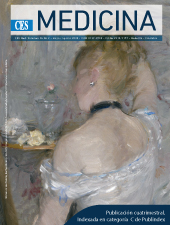Genomic and cytogenetic panorama of acute myeloid leukemias with recurrent genetic abnormalities
DOI:
https://doi.org/10.21615/cesmedicina.34.2.4Keywords:
Acute myeloid leukemia, Mutation, Genetics, Cytogenetic abnormalities, PrognosisAbstract
Acute myeloid leukemias are a heterogeneous group of diseases characterized by an increase in immature cells. Initially, acute myeloid leukemias were classified taking into account morphological data; however, with new diagnostic tools a more complete classification is established and comprising groups of chromosomal alterations and genetic mutations to which treatment is directed. Acute myeloid leukemias are associated with additional genetic mutations, which, in most cases, confer unfavorable characteristics to patients and often result in low rates of complete remission and frequent relapses.
Downloads
References
Lagunas-Rangel FA. Leucemia mieloide aguda. Una perspectiva de los mecanismos moleculares del cáncer. Vol. 15, Gaceta Mexicana de Oncologia. Masson-Doyma Mexico, S.A.; 2016:150–157.
Mahmood R, Altaf C, Malik HS, Khan SA. Clinico-haematologic association and prognostic relevance of npm1 and flt3-itd mutations in acute myeloid leukaemia. Pakistan J Med Sci. 2019;35(1):23–8.
Swerdlow SH, Harris NL, Jaffe ES, Pileri SA, Stein H, Thiele J, et al. WHO Classification of tumours of haematopoietic and lymphoid tissues. 4 edition. 2017. 586 p.
American Cancer Society. Estadísticas importantes sobre la leucemia mieloide aguda [Actualización más reciente: enero 8, 2020]. Disponible en: https://www.cancer.org/es/cancer/leucemia-mieloide-aguda/acerca/estadisticas-clave.html.
Brunner AM. No Mutation left behind: the impact of reporting recurrent genetic abnormalities on outcomes of patients with Acute Myeloid Leukemia. Acta Haematol. 2018;139(2):128–30.
Foucar K, Anastasi J. Acute myeloid leukemia with recurrent cytogenetic abnormalities. Am J Clin Pathol. 2015;144(1):6–18.
Muñoz D, Prada-Arismendy J, Castillo E. El papel de FLT3 como biomarcador en leucemia mieloide aguda. Arch Med. 2018;14(1):1–9.
Apidi E, Wan Taib WR, Hassan R, Ab Mutalib NS, Ismail I. A review on effect of genetic features on treatment responses in acute myeloid leukemia. Meta Gene 18 (2018) 31–8.
Dohner H, Estey E, Grimwade D , Amadori S , Appelbaum FR, Buchner T et al. Diagnosis and management of AML in adults: 2017 ELN recommendations from an international expert panel. Blood. 2017;129(4):424–48.
Pereira C, Brant C, Pimenta Á, Aguirre JC, Silva AJ, Hallack A, et al. Correlation between FLT3-ITD status and clinical, cellular and molecular profiles in promyelocytic acute leukemias. Leukemia Research 2015; (39):131–137.
Adams J, Nassiri M. Acute promyelocytic leukemia a review and discussion of variant translocations. Arch Pathol Lab Med. 2015;139(10):1308–13.
Madan V, Shyamsunder P, Han L, Mayakonda A, Nagata Y, Sundaresan J, et al. Comprehensive mutational analysis of primary and relapse acute promyelocytic leukemia. Leukemia. 2016;30(8):1672–81.
Fasan A, Haferlach C, Perglerovà K, Kern W, Haferlach T. Molecular landscape of acute promyelocytic leukemia at diagnosis and relapse. haematologica 2017;8:80-4.
Papaemmanuil E, Gerstung M, Bullinger L, Gaidzik VI, Paschka P, Roberts ND, et al. Genomic classification and prognosis in acute myeloid leukemia. N Engl J Med. 2016;374(23):2209–21.
Prada-Arismendy J, Arroyave JC, Röthlisberger S. Molecular biomarkers in acute myeloid leukemia. Blood Rev 31(2017) 63-76.
Knick B, Daver N, Garcia-Manero G, Ravandi F, Cortes J, Kadia T, et al. Minimal residual disease eradication with epigenetic therapy in core binding factor acute myeloid leukemia. 2013;498(7452):104–8.
Duployez N, Marceau-Renaut A, Boissel N, Petit A, Bucci M, Geffroy S, et al. Comprehensive mutational profiling of core binding factor acute myeloid leukemia. Blood. 2016;127(20):2451–9.
Kawashima N, Akashi A, Nagata Y, Kihara R, Ishikawa Y, Asou N, et al. Clinical significance of ASXL2 and ZBTB7A mutations and C-terminally truncated RUNX1-RUNX1T1 expression in AML patients with t(8;21) enrolled in the JALSG AML201 study. Ann Hematol. 2018;98(1):83–91.
Paschka P, Du J, Schlenk RF, Gaidzik VI, Bullinger L, Corbacioglu A, et al. Secondary genetic lesions in acute myeloid leukemia with inv(16) or t(16;16): A study of the German-Austrian AMLStudy Group (AMLSG). Blood. 2013;121(1):170–7.
Sood R, Hansen NF, Donovan FX, Carrington B, Bucci D, Maskeri B, et al. Somatic mutational landscape of AML with inv(16) or t(8;21) identifies patterns of clonal evolution in relapse leukemia. 2016;30(2):501–4.
Hsiao HH, Liu YC, Wang HC, Tsai YF, Wu CH, Cho SF, et al. Additional chromosomal abnormalities in core-binding factor acute myeloid leukemia. Genet Mol Res. 2015;14(4):17028–33.
Micol JB, Duployez N, Boissel N, Petit A, Geffroy S, Nibourel O, et al. Frequent ASXL2 mutations in acute myeloid leukemia patients with t(8;21)/RUNX1-RUNX1T1 chromosomal translocations. Blood. 2014;124(9):1445–9.
Cao XX, Cai H, Mao YY, Wu Q, Zhang L, Zhou D Bin, et al. Next-generation sequencing-based genetic landscape and its clinical implications for Chinese acute myeloid leukemia patients. Cancer Cell Int. 2018;18(1):1–6.
Hinai AA, Valk PJM. Review: Aberrant EVI1 expression in acute myeloid leukaemia. Br J Haematol. 2016;172(6):870–8.
Damgaard J, Coenen EA, Forestier E, Harbott J, Johansson B, Kerndrup G, et al. T(6;9)(p22;q34)/DEK-NUP214-rearranged pediatric myeloid leukemia: An international study of 62 patients. Haematologic. 2014;99(5):865–72.
Tarlock K, Alonzo TA, Palomo P, Gerbing RB, Raimondi SC, Hirsch BA, et al. Acute Myeloid Leukaemia (AML) with t(6;9)(p23;q34) is associated with poor outcome in childhood aml regardless of FLT3-ITD status: a report from the Children’s Oncology Group. Prog Retin Eye Res. 2008;26(1):38–56.
Wang HY, Rashidi HH. The new clinicopathologic and molecular findings in myeloid neoplasms with inv(3)(q21q26)/t(3;3)(q21;q26.2). Arch Pathol Lab Med. 2016;140(12):1404–10.
Groschel S, Sanders MA , Hoogenboezem R, Zeilemaker A, Havermans M, Erpelinck C, et al. Mutational spectrum of myeloid malignancies with inv(3)/t(3;3) reveals a predominant involvement of RAS/RTK signaling pathways. Blood 2015;125(1):133–9.
Hara Y, Shiba N, Ohki K, Tabuchi K, Yamato G, Park MJ, et al. Prognostic impact of specific molecular profiles in pediatric acute megakaryoblastic leukemia in non-Down syndrome. Genes Chromosom Cancer. 2017;56(5):394–404.
De Rooij JDE, Masetti R, Van Den Heuvel-Eibrink MM, Cayuela JM, Trka J, Reinhardt D, et al. Recurrent abnormalities can be used for risk group stratification in pediatric AMKL: A retrospective intergroup study. Blood. 2016;127(26):3424–30.
Patel JL, Schumacher JA, Frizzell K, Sorrells S, Shen W, Clayton A, et al. Coexisting and cooperating mutations in NPM1-mutated acute myeloid leukemia. Leuk Res 2017;56:7–12.
Medinger M, Passweg JR. Acute myeloid leukaemia genomics. Br J Haematol. 2017;179(4):530–42.
Bullinger L, Döhner K, Döhner H. Genomics of acute myeloid leukemia diagnosis and pathways. J Clin Oncol. 2017;35(9):934–46.
Metzeler KH, Herold T, Rothenberg-Thurley M, Amler S, Sauerland MC, Görlich D, et al. Spectrum and prognostic relevance of driver gene mutations in acute myeloid leukemia. Blood. 2016;128(5):686–98.
Kumar S, Raina V, Kumar L, Sharma A, Bakhshi R, Vishnubhatla S, et al. High FMS-like tyrosine kinase-3 (FLT3) receptor surface expression predicts poor outcome in FLT3 internal tandem duplication (ITD) negative patients in adult acute myeloid leukaemia: A prospective pilot study from India. Indian J Med Res Suppl. 2016;143(May):11–6.
Gholami M, Bayat S, Manoochehrabadi S, Pashaiefar H, Omrani MD, Jalaeikhoo H, et al. Investigation of CEBPA and CEBPA-AS Genes Expression in Acute Myeloid Leukemia. Reports Biochem Mol Biol 2019;7(2):136–41.
Wai Siong C, Kosmo B, Lee PL, Lee CK, Guo J, Chen Z, et al. CEBPA mutational analysis in acute myeloid leukaemia by a laboratory-developed next-generation sequencing assay. J Clin Pathol. 2018;71(6):522–31.
Tien FM, Hou HA, Tang JL, Kuo YY, Chen CY, Tsai CH, et al. Concomitant WT1 mutations predict poor prognosis in acute myeloid leukemia patients with double mutant CEBPA. Sci York. 2011;40(2):308–24.
Grossmann V, Haferlach C, Nadarajah N, Fasan A, Weissmann S, Roller A, et al. CEBPA double-mutated acute myeloid leukaemia harbours concomitant molecular mutations in 76·8 % of cases with TET2 and GATA2 alterations impacting prognosis. Br J Haematol. 2013;161(5):649–58.
Downloads
Published
How to Cite
Issue
Section
License
Copyright (c) 2020 CES Medicina

This work is licensed under a Creative Commons Attribution-NonCommercial-ShareAlike 4.0 International License.
Derechos de reproducción (copyright)
Cada manuscrito se acompañará de una declaración en la que se especifique que los materiales son inéditos, que no han sido publicados anteriormente en formato impreso o electrónico y que no se presentarán a ningún otro medio antes de conocer la decisión de la revista. En todo caso, cualquier publicación anterior, sea en forma impresa o electrónica, deberá darse a conocer a la redacción por escrito.
Plagios, duplicaciones totales o parciales, traduccones del original a otro idioma son de responsabilidad exclusiva de los autores el envío.
Los autores adjuntarán una declaración firmada indicando que, si el manuscrito se acepta para su publicación, los derechos de reproducción son propiedad exclusiva de la Revista CES Medicina.
Se solicita a los autores que proporcionen la información completa acerca de cualquier beca o subvención recibida de una entidad comercial u otro grupo con intereses privados, u otro organismo, para costear parcial o totalmente el trabajo en que se basa el artículo.
Los autores tienen la responsabilidad de obtener los permisos necesarios para reproducir cualquier material protegido por derechos de reproducción. El manuscrito se acompañará de la carta original que otorgue ese permiso y en ella debe especificarse con exactitud el número del cuadro o figura o el texto exacto que se citará y cómo se usará, así como la referencia bibliográfica completa.
| Article metrics | |
|---|---|
| Abstract views | |
| Galley vies | |
| PDF Views | |
| HTML views | |
| Other views | |



